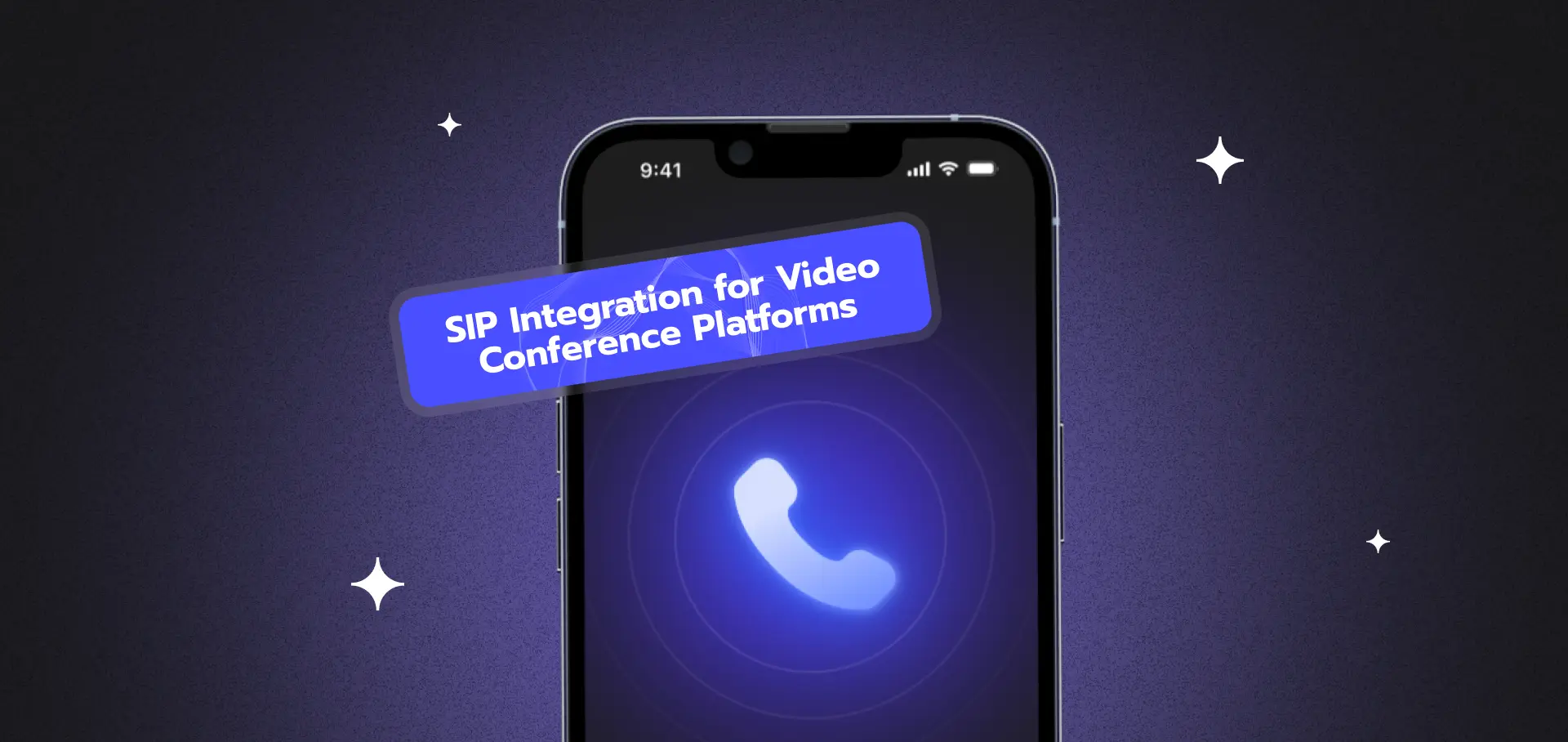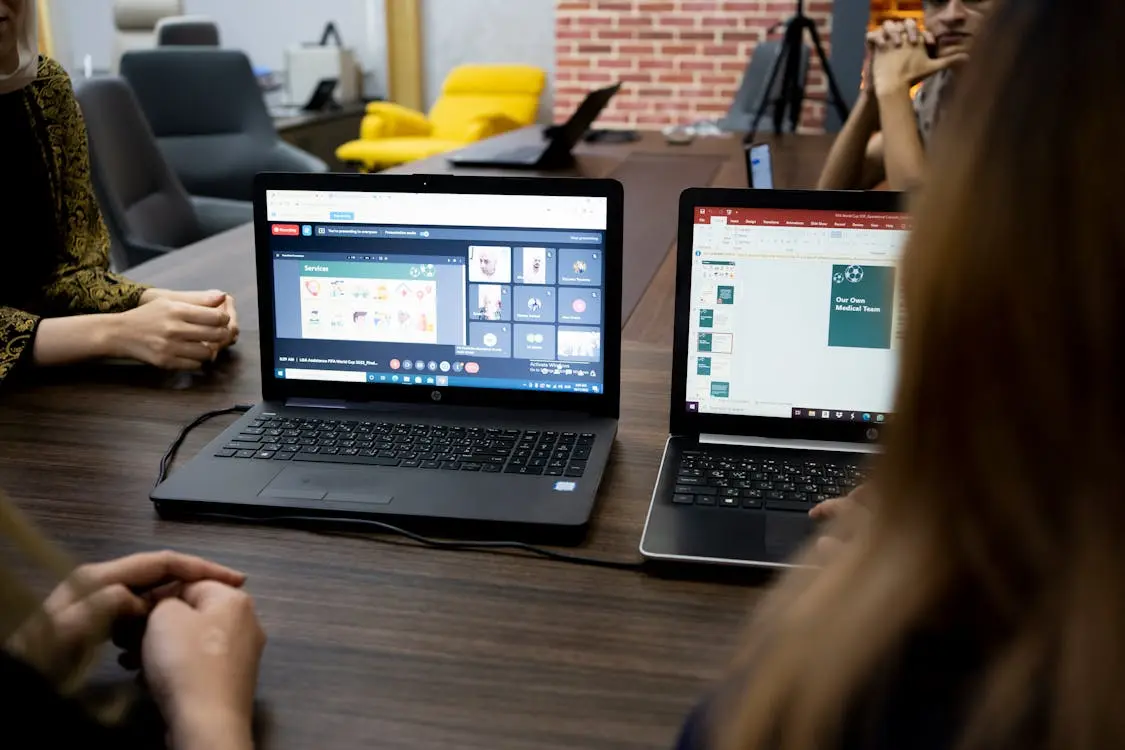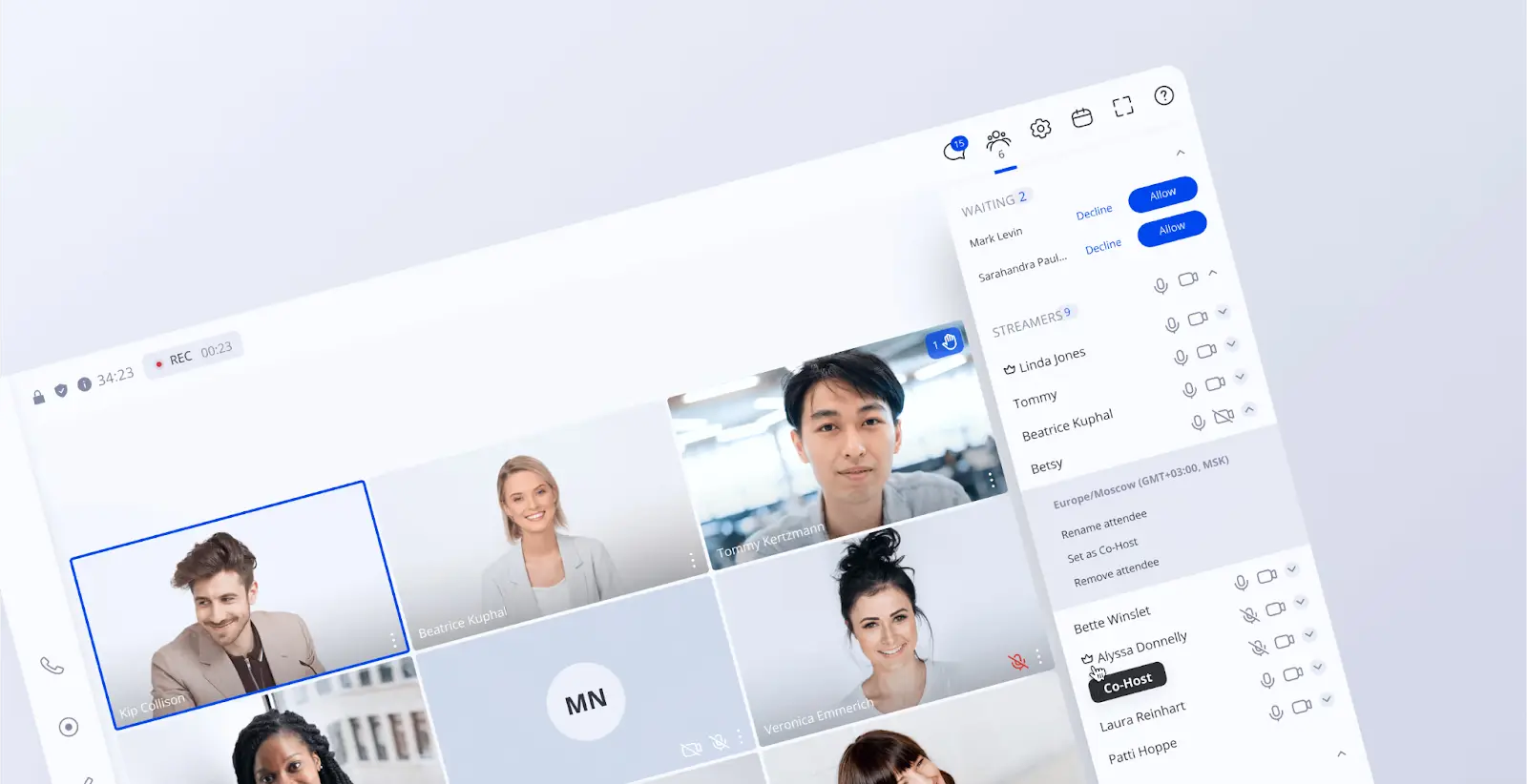
Ever tried joining a video call only to find out some participants can only use their old office phones?
That's where SIP integration for video conferencing comes in handy. This smart technology acts like a bridge between modern video platforms and traditional phone systems, making it possible for everyone to join the conversation, regardless of their setup. By using special servers and gateways, SIP integration smoothly connects digital video calls with regular phone lines, so nobody gets left out of the meeting.
Plus, with cloud-based options available, businesses can handle lots of calls at once without dropping connections. Whether you're running a small team meeting or a large corporate event, SIP integration helps keep everyone connected and talking.
Understanding Modern SIP Video Conferencing

Modern SIP (Session Initiation Protocol) video conferencing has come a long way, now offering features that weren't possible before. Video conferencing has transformed how we communicate, with studies showing increased eye contact during video interactions compared to traditional voice calls, leading to stronger interpersonal connections (Boland et al., 2022).
At its heart are a few core components that make it work for users. These components include the SIP client, which is the software users interact with, the SIP server that handles the heavy lifting in the background, and gateways that help different types of systems talk to each other.
Why Trust Our Video Conferencing Expertise?
At Fora Soft, we've been at the forefront of video streaming and multimedia solutions for over 19 years, specializing in developing robust video conferencing systems that leverage modern SIP integration. Our team has successfully implemented numerous video conferencing solutions, maintaining a 100% success rate on Upwork and establishing ourselves as leaders in WebRTC, LiveKit, and Kurento technologies.
Our expertise in SIP video conferencing isn't just theoretical – we've developed real-world solutions like ProVideoMeeting, where we've implemented advanced features such as AI-powered monitoring and cross-platform compatibility. Our deep understanding of both traditional telephony and modern video streaming allows us to create seamless hybrid solutions that bridge the gap between conventional communication systems and cutting-edge video conferencing technology.
Core Components of SIP Integration
SIP, or Session Initiation Protocol, is like the language that lets video conferencing tools talk to each other.
Modern systems are improving this language with AI, making it smarter and more efficient.
Some solutions even move the whole process to the cloud, using something called cloud-native SIP trunking, which can handle lots of calls at once and lead to significant cost savings (Nozoe et al., 2022).
Session Initiation Protocol Fundamentals
When talking about video conferencing, understanding the fundamentals of the protocol that makes it all happen is vital. Session Initiation Protocol (SIP) is a signaling protocol that enables enterprise video conferencing and is extensively used in video conferencing platforms.
It handles the setup and teardown of multimedia communication sessions, including video, voice, and other media. SIP determines the endpoints for the session, the format to be used, and manages the connection.
It's like the traffic cop directing the flow of communication between participants. SIP works with various devices and networks, making it adaptable for integrating different communication services.
AI-Enhanced SIP Architecture
Today, AI plays an essential role in enhancing the architecture of SIP for video conferencing. It boosts efficiency by integrating ai-powered meeting tools that improve call quality and manage resources better. Here's a quick view of how AI enhances SIP:
These components work together to make video conferencing more reliable and user-friendly for end users.
Cloud-Native SIP Trunking Solutions
Cloud-native SIP trunking solutions have revolutionized the way video conferencing platforms operate. These solutions employ cloud storage to manage and route voice and video data efficiently, while significantly reducing operational expenses by eliminating the need for extensive on-premises hardware - with potential cost savings of up to 50% (Kaul, 2018).
By integrating these systems, video conferencing tools can connect seamlessly with existing phone lines, enhancing call quality and reliability. End users benefit from better performance and reduced latency, making their video conferencing experience smoother and more engaging.
This setup also allows for easier scalability, as cloud infrastructure can adjust to handle increased loads without considerable downtime. For product owners, this means improved service delivery and happier customers.
Technical Implementation Guide
Integrating SIP for video conferencing often means setting up systems that handle both voice and video. It involves combining traditional phone calls with video streams.
This setup is called a hybrid voice/video system, which lets users switch between voice and video seamlessly.
Setting Up Hybrid Voice/Video Systems
This guide focuses on launching hybrid voice/video systems for SIP-integrated video conference platforms. There are three key areas to examine: the necessary tools and safeguards known as Infrastructure Requirements and Security.
How to link traditional phone networks through the PSTN Gateway Integration Process, and ways to enhance performance via Quality of Service Optimization. Each of these plays a big role in making sure the video conference runs smoothly.
Infrastructure Requirements and Security
Setting up hybrid voice/video systems involves more than just connecting software components; it requires a sturdy infrastructure and stringent security measures. Incorporating cloud calling into video conferencing services demands reliable servers, resilient firewalls, and secure databases. Here's a breakdown of essential infrastructure and security elements:
This setup ensures smooth integration of SIP with existing systems, enhancing overall functionality for end-users.
PSTN Gateway Integration Process
After guaranteeing the infrastructure and security measures are in place, the next step involves understanding the PSTN Gateway integration process. This component connects traditional phone lines with enterprise meeting software.
To start, the PSTN gateway translates signals between the old phone system and the new digital networks. The gateway handles call routing and guarantees that voice data flows smoothly between digital and analog systems.
This integration is essential for hybrid voice/video systems, allowing end-users to join conference calls using regular phones. The setup generally requires configuring the gateway to work with the video conference platform's API, ensuring seamless communication.
Quality of Service Optimization
In a hybrid voice/video system, how does one guarantee that calls are clear and uninterrupted? It’s all about Quality of Service (QoS) optimization. This involves prioritizing voice and video packets over other data.
For business meetings, ensuring low latency and minimal packet loss is essential. This directly affects the meeting experience. Developers can use QoS settings to control bandwidth, reducing jitter and delay. This guarantees smoother conversations and clearer video, enhancing overall user satisfaction.
Techniques like traffic shaping and prioritization are key. They help manage network congestion, ensuring that important packets for voice and video aren't dropped or delayed. Implementing these strategies can profoundly improve the reliability and quality of hybrid systems.
Real-World Implementation: ProVideoMeeting's Hybrid Solution

At Fora Soft, our development of ProVideoMeeting showcases the practical implementation of modern SIP integration. Our team focused on creating a hybrid system that allows users to join video conferences either through internet connections or by dialing in through traditional phone lines. This flexibility was achieved through careful SIP integration and PSTN gateway configuration, ensuring seamless communication regardless of the connection method. The platform's ability to handle both video and voice calls demonstrates the power of well-implemented hybrid voice/video systems in real-world applications.
Future-Ready Integration Strategies
Looking ahead, SIP integration can open doors to advanced features like screen sharing and virtual backgrounds.
It can also pave the way for innovations such as augmented reality (AR) overlays during video calls. These elements focus on enhancing user experience and making video conference platforms more engaging.
Advanced Features and Innovations
The future of SIP integration for video conference platforms looks bright with several advanced features on the horizon. AI-powered monitoring and analytics can spot issues before users notice them, ensuring smoother meetings.
Meanwhile, cross-platform client development and immersive meeting technologies, like virtual reality, are becoming more common. These advancements are making video conferences more engaging for users, regardless of their device.
AI-Powered Monitoring and Analytics
Imagine a video conference platform that can detect when a participant is having trouble understanding the speaker. This is possible with AI-powered monitoring and analytics.
Video analytics can track engagement levels, identifying confusion or distraction. AI assistants can then offer help, like sending a private message to the participant or rephrasing complex sentences.
Here's what it can do:
- Real-time Sentiment Analysis: The AI can read facial expressions to tell if someone's confused or unhappy.
- Automatic Transcription: Words can be turned into text in real-time, helping those with hearing difficulties.
- Voice Patterns: The AI learns speaking styles. If someone talks too fast, it can ask them to slow down.
- Predictive Analytics: By tracking past behaviors, the AI can predict when someone might need help.
Cross-Platform Client Development
How can developers guarantee their video conference platform is accessible to the widest audience possible? They can adopt cross-platform client development. This means creating software that works on different devices and operating systems. It allows team collaboration and remote work to happen seamlessly.
Gone are the days of installation hassles due to compatibility issues. This development approach combines features for integration into native apps. Developers blend web technologies, such as JavaScript and HTML, together to create cost-efficient applications. As a result, real-time video conferencing and messaging are simplified.
Immersive Meeting Technologies Integration
Enhancing the user experience in video conferencing platforms, developers are integrating immersive meeting technologies. These advancements focus on making virtual meetings more engaging and lifelike.
Key features include:
- Interactive Video: Users can now interact with content in real-time, making meetings more dynamic.
- Augmented Reality (AR): AR overlays enhance presentations, allowing speakers to use 3D models and animations.
- Virtual Backgrounds: Customizable backdrops create a more professional or fun environment, depending on the meeting's tone.
- Spatial Audio: Sound is positioned based on participants' locations, mimicking in-person conversations.
These integrations are set to revolutionize the way users experience virtual meetings, making them more natural and immersive.
SIP Integration Architecture Builder
Understanding how SIP integration connects different communication systems can be complex. This interactive tool lets you build a visual SIP architecture by dragging and dropping components, showing how traditional landlines, video conferencing platforms, and cloud services work together. Perfect for product owners planning their communication infrastructure upgrades.
Frequently Asked Questions
What Is the Cost of SIP Integration?
The cost of SIP integration varies widely based on factors such as the service provider, the intricacy of the integration, and additional features required. It can range from minimal monthly fees for basic services to thousands of dollars for all-encompassing enterprise solutions. Providers typically offer customized pricing based on specific needs, with costs influenced by the number of users, call volumes, and advanced functionalities like call routing and failover mechanisms. Businesses should consider both initial setup costs and ongoing expenses when evaluating SIP integration options.
Can I Use My Existing Landline Number?
The individual can potentially use their existing landline number, depending on their service provider's features and the specific technology in use. Number porting or forwarding might be required. It is best confirmed with the service provider.
How Does SIP Integration Affect Call Quality?
SIP integration's impact on call quality varies. With proper network configuration and adequate bandwidth, it can enhance voice clarity and reliability. However, improper setup or insufficient bandwidth can lead to issues like dropped calls, latency, and poor audio quality.
Is SIP Integration Supported in My Country?
To determine if SIP integration is supported in a specific country, one must consider local telecommunications regulations and the service providers operating in that region. It is essential to consult with local service providers or regulatory bodies to confirm availability and compliance with national standards. particular countries may have restrictions or specific requirements for SIP integration due to security or infrastructure considerations. Researching or contacting local experts can provide definitive answers.
What if My Landline Is Part of a Bundle?
If a landline is part of a bundle, service providers often group it with internet and TV services. This bundling can sometimes restrict the landline's compatibility with particular technological integrations, depending on the provider's policies and the specific services included in the bundle. Customers should consult their service provider for detailed information on the landline's usage within the bundle and any potential limitations.
To Sum Up
SIP integration can connect old-school landlines to modern video conference platforms. This makes it easier for users to join video calls using their regular phones. It involves setting up core components like SIP trunks and configuring them with video platforms. Developers can build hybrid systems combining voice and video. They can also add advanced features, ensuring the system is ready for future updates. This combines the reliability of landlines with the interactivity of video conferencing, offering flexibility for users.
References
Boland, J., Fonseca, P., & Mermelstein, I., et al. (2022). Zoom disrupts the rhythm of conversation. Journal of Experimental Psychology General, 151(6), 1272-1282. https://doi.org/10.1037/xge0001150
Kaul, S. (2018). Clustering and resilience in cloud video conference solutions. European Journal of Electrical Engineering and Computer Science, 2(6). https://doi.org/10.24018/ejece.2018.2.6.41
Nozoe, T., Noguchi, M., & Sakuma, M., et al. (2022). Live migration of virtualized carrier grade sip server. International Journal of Communication Networks and Information Security, 8(2). https://doi.org/10.17762/ijcnis.v8i2.1297













.avif)

Comments